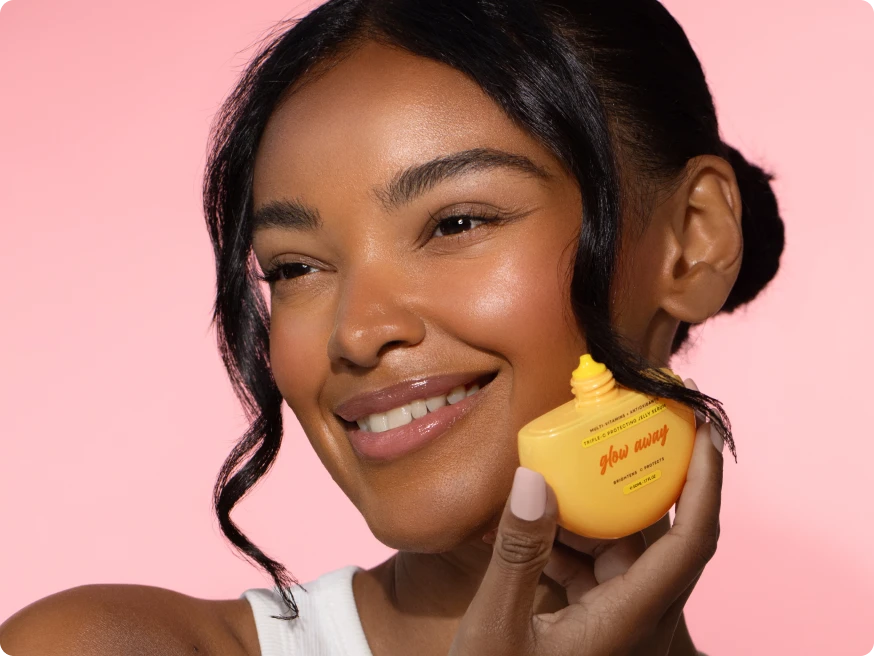What is the skin microbiome?

The Skin Microbiome
Your skin is your largest organ and acts as a protective barrier between your body and your surrounding environment. It has a number of different defense mechanisms that contribute to its protective effect including a physical lipid barrier, an acidic pH, immune cells, and a diverse microbiome.
Your skin microbiome is the first thing that any infection-causing bacteria will come into contact with which makes it very important for preventing skin diseases and infections.You’ve probably heard of microbiome-friendly or probiotic skincare but you may not know what your microbiome actually is, how you can look after it, and whether these ingredients actually work to protect it.
What is the skin microbiome?
Your skin microbiome (or normal flora) is a community of millions of different microorganisms that live on the surface of your skin and help keep your skin healthy. It’s mainly made up of bacteria, fungi, viruses, and mites.Although it may not sound like it, these microbes are very beneficial to your skin.
When your skin microbiome is balanced it helps to keep your skin healthy by preventing pathogens (bad bacteria) from penetrating it. The microbes can also help program the immune cells in your skin to respond to any bad bacteria that do manage to get through your skin’s barrier.
- epidermidis is considered to be one of the main beneficial bacteria in your skin microbiome and accounts for up to 90% of your good bacteria. Research has shown that it helps to maintain your skin barrier, aid wound healing, and prevent melanoma.
- acnes is another key bacteria in your skin microbiome that creates substances like propanoic acid which helps maintain your skin pH and has antibacterial effects.
One of the more problematic bacteria present on your skin is S. aureus which doesn’t cause much of an issue when it’s balanced (although it does contribute to body odor) but causes problems when it begins to outnumber your good bacteria.
The mixture of bacteria in your skin microbiome varies all over your body as different microbes thrive in different conditions. For example, S. aureus thrives in warm and moist conditions like your groin and armpits while C. acnes likes oil-rich areas of skin like your face, scalp, and back.
There are a few other factors that affect the diversity of the bacteria in your skin microbiome, including:
- Your hormones - a teenage girl will have a different microbiome from a post-menopausal woman.
- Your age - teenagers produce more oil than adults and have an increased number of acnes bacteria.
- Your gender - the female microbiome is more diverse than the male microbiome due to thinner skin, lower pH, and less intense sweat production.
Why is a balanced skin microbiome important?
As well as protecting your skin from infection, research has identified a number of other ways that a healthy, balanced microbiome affects your skin health..
For example, a balanced microbiome:
- Improves the quality of your skin barrier
- Reduces inflammation
- Protects against various skin diseases (e.g. eczema)
- May offer your skin some protection against UV radiation
Your skin microbiome isn’t only present on the surface of your skin but can also be found in the deeper layers, like your dermis and subcutaneous layer.
Although the idea of microbes deep in your skin sounds like it should be a bad thing, it’s actually another way that your microbiome helps protect you.
These deeper microbes work hand-in-hand with your skin cells and immune cells to keep your skin healthy and free from infection. For example, when your skin microbiome is unbalanced, your immune system sends out antibacterial peptides to help rebalance things.
If your skin microbiome is healthy, it can return the favor by preventing the release of inflammatory markers from your immune system which leads to less skin inflammation.
What happens when your skin microbiome is unbalanced?
An unbalanced microbiome (dysbiosis) means that you have less beneficial bacteria on your skin and an increase in bad bacteria and/or good bacteria that can become bad bacteria under certain conditions.
For example, some of the key bacteria that make up your skin microbiome, particularly C.acnes and S.epidermidis, help protect your skin when they are balanced. However, they can easily shift into ‘opportunistic pathogens’ when they are not.
Some skin conditions are also associated with an imbalance of these bacteria:
- Atopic dermatitis (eczema) is associated with an increase in aureus (as well as an increase in S. epidermidis during flares) and a decrease in C. acnes and lactobacilli.
- A decrease in acnes and lactobacilli has also been found in psoriasis.
- An increase in acnes is one of the key characteristics of acne.
An unbalanced microbiome has also been associated with dryness, premature skin aging, and skin sensitivity.
How to maintain a balanced skin microbiome?
Your skin microbiome is heavily influenced by the pH of your skin which is naturally acidic (pH 4.7 - 5.9) and controlled by a mixture of sebum, sweat, lactic acid, and fatty acids that create a film-like covering on the surface of your skin (your acid mantle).
It’s important to keep your skin pH in this range as it allows your good bacteria to thrive while limiting the growth of bad bacteria which prefer a more alkaline pH (above 7.0).
If your skin pH is elevated, these bad bacteria multiply and outnumber your good bacteria which results in an unbalanced microbiome.Not only does this increase your risk of skin infection from the bacteria present in your environment but it also alters the behavior of your good bacteria.
There are a number of things that can throw your skin’s microbiome off balance, including:
- Sun damage
- Skincare products
- Antibiotic treatments
- Pollution
- Diet
- Over-exfoliation
How do skin care products affect your microbiome?
The most common cause of an elevated skin pH and unbalanced microbiome is the skincare products that you use, particularly soaps and harsh cleansers.
Soaps, in particular, have a very alkaline pH (around 10.5 - 11.0) which causes your skin’s pH to rise for a few hours after using them.
A better alternative is a pH-balanced cleanser which is formulated at the same pH as your skin. These cleansers still cause a slightly elevated skin pH after you use them but this is to a much lesser extent and for a shorter period of time - similar to the pH changes seen when cleansing with water alone.In other words, the further away a product's pH is from your natural skin pH, the longer it will take your skin microbiome to rebalance itself after use.
The preservatives in your skincare products also have an effect on your skin microbiome.Preservatives are ingredients that are added to cosmetics in order to prevent bacteria and mold from growing on your products and ruining them. They’re especially important for water-based cosmetics.
Examples of common preservatives include:
- Phenoxyethanol
- Ethylhexylglycerin
- Benzyl Alcohol
- Sodium Benzoate
Research suggests that different combinations of preservatives have different effects on your skin microbiome. For example, the combination of sodium benzoate, phenoxyethanol, and ethylhexylglycerin was able to reduce the growth of the C.acnes and S.aureus bacteria without preventing the growth of the friendly S. epidermidis bacteria.However, other preservative combinations did reduce the growth of the S. epidermidis bacteria, which means that they wouldn't be a great choice for skincare products that aim to maintain your skin microbiome.
Best skincare ingredients for maintaining your skin microbiome
There are two main ways that skincare ingredients can help keep your microbiome balanced:
- By encouraging the growth of good bacteria
- By maintaining your skin's naturally acidic pH
Skincare ingredients that encourage good bacteria growth
Probiotic, prebiotic, and postbiotic skincare claims to rebalance your microbiome by providing your skin with more good bacteria and/or feeding your good bacteria more nutrients.
Probiotics
Probiotics are live bacteria that provide some sort of health benefit for your body. The most commonly used probiotics are:
- Lactobacillus
- Bifidobacterium
- Bacillus coagulans
- Vitreoscilla
Research has shown that topical probiotics can improve inflammatory skin conditions, including acne, eczema, and rosacea.
They can also:
- Improve skin barrier function by increasing ceramide production
- Increase collagen production
- Protect against premature skin aging
There are two main types of probiotics found in skincare - para-probiotics and lysates.
Para-probiotics are inactivated bacteria while lysates are bacterial fragments that are created through fermenting food.
Prebiotics
Prebiotics are the nutrients that probiotics live off of. They help feed your good bacteria which allows them to grow and keeps your microbiome balanced. The majority of prebiotics are carbohydrates like fructo-oligosaccharides and galacto-oligosaccharides.
There’s less research regarding prebiotics but many different skincare ingredients can have prebiotic effects. For example, research suggests that colloidal oats may be used by the good bacteria on your skin which can enable an increased rate of growth, metabolism, and lactic acid production. Ceramides and other lipids can also act as a food source for your good bacteria while also strengthening your skin barrier and increasing skin hydration.
Postbiotics
Postbiotics are the substances that probiotics produce that provide all their skin-supporting benefits. In some ways, these may be the best type of biotic to use in skincare as they’re providing the same benefits that your good bacteria do.
Examples include:
- Peptides
- Enzymes
- Fatty acids
Hyaluronic acid and lactic acid may also be considered postbiotics as they can be byproducts of bacterial fermentation processes.
Skincare ingredients that maintain skin pH
Acidic skincare ingredients can help keep your skin microbiome balanced by keeping your skin pH within its ideal range. For example:
- Glycolic Acid
- Salicylic Acid
- Ascorbic Acid
One acid that’s particularly beneficial is lactic acid. Lactic acid is an alpha hydroxy acid (AHA) found in milk. It’s also a natural component of your skin's natural moisturizing factors (NMFs) and is produced by the bacteria on your skin. One of the best things about lactic acid, when it comes to your skin microbiome, is that it’s selectively antibacterial and prevents the growth of bad bacteria without affecting your good bacteria. Exfoliating acids, like glycolic acid, lactic acid, and salicylic acid should only be used 1-3 times per week to prevent the risk of over-exfoliation which can damage your skin barrier and negatively affect your skin microbiome.
However, ascorbic acid (the active form of vitamin C) can be used once or twice a day as long as your skin can tolerate it.
Other ways to look after your microbiome
In addition to skincare, there are a few other ways that you can look after your skin microbiome.
For example:
- Looking after your gut microbiome
- Moisturizing
- Reducing stress
- Exercising regularly
Look After Your Gut Microbiome
The past decade has highlighted just how important your gut microbiome is for your physical and mental health. An altered gut microbiome has also been associated with a variety of different skin disorders including acne, eczema, psoriasis, dandruff, and even skin cancer. Research suggests that there is also a link between your gut microbiome and your skin microbiome which suggests that probiotics may help balance your skin microbiome when taken orally as well as when applied to your skin.
Oral probiotics have also been associated with increased skin thickness, improved skin barrier function, and reduced skin sensitivity. They can also improve inflammatory skin conditions like acne, eczema, and rosacea. Probiotics and prebiotics can be found in capsules, yogurts, and fermented foods.
Moisturize Your Skin
Moisturizing is an essential part of any skincare routine as it keeps your skin barrier healthy and strong. Research suggests that the lipids in your moisturizers may also help to support your skin microbiome. They can act as nutrients for lipid-loving bacteria, like S. epidermis and C. acnes.
One study found that moisturizers were able to increase the diversity of the skin microbiome but reduced the number of C. acnes. One reason for the reduction in C. acnes could be the fact that moisturizers increase skin hydration which also happens to reduce the production of the oil that C. acnes thrives in. Look for moisturizers that contain skin-identical lipids like ceramides, cholesterol, and fatty acids for the best results.
In addition, hydrating ingredients like hyaluronic acid and lactic acid can have postbiotic effects.
Reduce Stress
It’s well known that stress can have a negative impact on your physical and mental health. However, it has also been shown to suppress the production of antimicrobial peptides which can increase your risk of infection, as well as reduce skin barrier function. As antimicrobial peptides have a key role in balancing your skin microbiome, increased stress levels may throw your skin microbiome off balance. There are a number of different ways that you can reduce stress, including through exercise, meditation, and making time for yourself.
Exercise Regularly
Not only does exercise have excellent benefits for your overall health, but it can also keep your skin looking healthy and youthful by increasing the blood flow to your skin. This helps deliver oxygen and nutrients to your skin cells and remove pollutants like the free radicals that cause premature skin aging.
Exercise can also have some surprising benefits for your skin microbiome. For example, the salts secreted from your sweat can act as prebiotics to feed your good bacteria and keep your microbiome balanced. Sweat also contains lactic acid which is one of the best skincare ingredients for maintaining your skin’s pH and a healthy microbiome.
Conclusion
Your skin microbiome is a diverse collection of bacteria and other microbes that help keep your skin healthy and protect it from infection. When your skin microbiome becomes unbalanced, you’re more likely to experience skin conditions like acne, eczema, and rosacea.
One of the main causes of an unbalanced microbiome is skincare products that elevate your skin’s pH level. A higher skin pH creates the perfect environment for bad bacteria to thrive and can even turn your good bacteria bad. You can look after your skin microbiome by using skincare products that maintain your skin’s pH level, like lactic acid, or by feeding your good bacteria with probiotics both orally and topically.
0 comments





